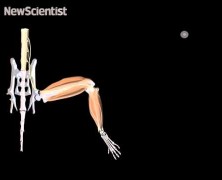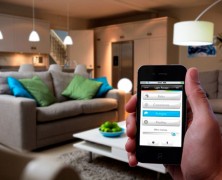Straight from the pages of science fiction, a team at King’s College in London has reversed paralysis using stem cell neurons treated with blue LED light. The trials took place in April of this year, during which scientists were able to restore muscular function in the formerly paralyzed legs of mice. The Wall Street Daily recently followed up with a report confirming the vital role that LED light played in this experiment. Additional testing is now being done to create a usable model for human trials, and time will tell if indeed LED light beats paralysis for good. The team used stem cells that contained neurons with a unique twist – a light sensitive gene that has the same biological structure as marine algae. These specially engineered cells were implanted into the exposed nerves of a paralyzed mouse, and then things really got interesting. The cells were exposed to blue LED light, and this triggered a connection between the nerve and the muscle, which essentially reverses paralysis. Scientists were able to adjust the intensity of the muscle’s contraction simply by varying the duration, intensity, and frequency of the LED light flashes. This procedure shows promise for restoring muscular function in individuals who suffer from spinal cord injuries and motor neuron diseases. Further, it is a dramatic improvement over existing paralysis treatments that use electrical stimulation, which are often painful and cause rapid muscle fatigue. In practice, this will basically be a tiny optical pacemaker that has a blue LED light built into it. The implanted pacemaker will consistently flash light onto the special neurons, thus allowing normal muscular function. The team at King’s College plans to develop this pacemaker within the next five years....
Home Automation LED Lighting Systems...
posted by Flexfire LEDs
How would you like an LED lighting system in your home that matched your body’s natural rhythms, optimizing your mental and emotional well-being? Or how about LED strip lights connected to motion sensors that guide you to the bathroom in the middle of the night? With home automation LED lighting systems, these are fully feasible options for today’s 21st century home owner. A home automation system uses wireless networking technology to program and remotely control common household systems including lighting, appliances, HVAC (heating, ventilation and air conditioning), or the locks of gates and doors, among other common home necessities. Rightfully so, there has been quite a bit of attention given to home automation in recent years. Home automation LED lighting systems, for instance, are more convenient, more energy efficient, and ultimately more exciting than traditional home lighting systems. Such systems exemplify the use of technology for real human benefit, in contrast to many convoluted technological “solutions” that make things even more difficult. Simplicity is a tremendously important feature as the world looks to reduce its carbon footprint through the automation of routine tasks. How do home automation LED lighting systems work? Imagine your home with a full network of LED lights that you can control with an app on your phone or computer. Not quite sure what that would look like? Here are a few examples of the kind of control you would have: Motion sensors turn on/off and dim automated LED lights when you enter or leave rooms Turn off all the interior lights in your home with a simple click of an app button Use your smartphone to remotely monitor and adjust the lighting in your home while away on vacation An intelligent lighting system that turns on the lights at sunset and turns them off...
Red LED Light Delays Aging in Broccoli...
posted by Flexfire LEDs
Joining similar agricultural studies around the globe, Japan’s Shizuoka University recently found that exposure to red LED light delays aging in broccoli. Researchers from the school’s Department of Biological and Environmental Sciences examined the effects of exposing broccoli to red and blue LED lighting just after harvest, and the results suggest the possibility of both extending the vegetable’s life and improving its nutritional quality. Specifically, exposure to red LED lighting was shown to delay the yellowing process, suppressing ethylene production and reducing ascorbate (AsA). Blue LED lighting did not significantly delay broccoli aging in this way. The full results were originally published in Postharvest Biology and Technology. So what does this mean for a potentially vegetable-optimized future? Will the supermarket produce section soon become a literal red light district? Might red LED kitchen lighting be the next design trend for health-conscious homeowners? Stay...
LED Lighting Health Benefits...
posted by Flexfire LEDs
Earlier this month at the 2014 Consumer Electronics Show, the Rensselear Polytechnic Institute’s Smart Lighting Engineering Research Center demonstrated a personal light measurement system that will assist in accurately monitoring the body’s circadian rhythm. Designed for Google Glass, the prototype captures an individual’s light exposure and biometric signals, then sends this information to an Android app. The app then provides information that will help the individual achieve better sleep cycles, in turn leading to improved overall health and productivity. This project is the latest of many to explore LED lighting health benefits. So what do LED lights have to do with this? Among all light sources, LEDs are unique in that they can be tuned to control light direction, color temperature, and overall illuminance. LEDs thus play a key role in so-called “human-centric lighting”, which examines lighting exposure as a means to address modern health issues. This is particularly relevant given the ever-increasing amount of time we spend indoors, not to mention the fact that many in the Northern Hemisphere live with little to no sunlight each winter. Imagine this: you live in northern Sweden, where prolonged periods without daylight turn you into a depressed, grumpy, unproductive mess. Along comes a device that measures your personal light intake each day, then automatically tells your home lighting system how much and what sort of light your body needs to function properly. Sounds like science fiction, right? Check out RPI’s Healthy Home Project in Sweden. According to a report published in part by LightingEurope, the use of human-centric lighting helps improve sleep, increase productivity, accelerate healing and even prevent some chronic diseases. LEDs promise to play a central part in this exciting new field of research, and it will be interesting to see where this takes us...









